Heat/ cold/ wound care – Flashcards
Unlock all answers in this set
Unlock answersquestion
what are the indications for heat therapy?
answer
Reduces muscle tension vasodilation
question
how does heat therapy reduces muscle tension??
answer
Promotes muscle relaxation, which lowers pain d/t spasm or stiffness
question
2 ways heat therapy does vasodilation?
answer
increase blood flow to the injured part, which brings nutrients and removes waste. It lessens congestion of blood in the injured tissues
question
what are the conditions of heat therapy??
answer
inflamation/ edema infected wound surgical wound arthritis and joint disease localized joint pain muscle stains lo back pain menstrual cramps perineal inflammations
question
types of heat therapy??
answer
Aquathermia pad Sitz bath Paraffin Bath Commercial Hot packs Heating pad
question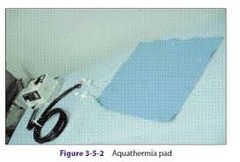
aquathermia pad

answer
water-flow pad 105-110 circulates waterproof plastic or rubber pad connected to electronically control unit 20-30 mins
question
2 types of aquathermia pad
answer
moist vs dry
question
dry aquathermia pad
answer
just put it on
question
moist aquathermia
answer
applied wet towel or pad
question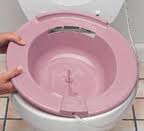
sitz bath

answer
100-105 for perineal area ( NOT LEGS) heat therapy ro pelvic region
question
when will you use sithz baths??
answer
May be ordered following rectal surgery, childbirth, for painful hemorrhoids or vaginal inflammation
question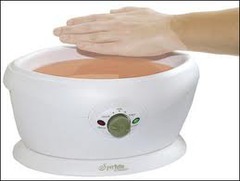
paraffin bath

answer
heated paraffin wax
question
why would you use paraffin bath??
answer
Treat painful arthritis of the hands and feet with penetrating heat therapy Relieves pain and stiffness
question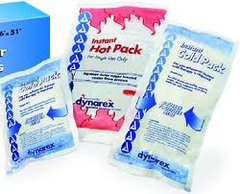
commercial hot pack/ heating pad

answer
commercial hot packs : Hit or Kneaded to mix the chemicals that release heat Deliver dry heat therapy to injured area heating pad : Electrical pads Moist and dry
question
safety issue for heat therapy?
answer
do not use when bleeding dry heat small pad to avoid pain
question
never do while using heating pad ??
answer
Avoid using high settings Never lie on the heating pad Never use safety pins through pad Not recommended in acute care facilities
question
important things for heat therapy
answer
apply heat for proper intervals because it is too long, will get the opposite effect. damage cells, blistering and other complications.
question
indications for Cold Therapy 3
answer
vasoconstriction low localized pain by acts as anesthesia less bleeding by increasing blood viscosity which causes coagulate at site of injury
question
what is vasoconstriction ?
answer
reduced blood flow to an injured part prevents edema and reduces in inflammation
question
what are conditions for cold therapy??
answer
Strains, sprains, fractures, muscle spasms(direct trauma) Laceration or puncture wound Minor burn Injections Arthritis (numbing pain) Joint trauma Area of injury or pain where cancer is suspected
question
what are some contraindications of cold therapy??

answer
Edema is already present Patient has poor circulation Patient is shivering Patient is disoriented or unresponsive
question
safety for cold therapy
answer
59 F less than 20 min at a time
question
before applying cold assessment ?
answer
Circulation and Pulses Skin color and temp Edema Sensation (response to stimuli)
question
adverse reactions
answer
Burning or numbness Mottling of the skin Erythema Extreme paleness of skin Bluish discoloration of skin
question
what are types of cold therapy?
answer
moist cold therapy - wet compressess dry cold therapy -icepacks -ice collar
question
what are ice pacts for?
answer
muscle sprain local hemorrhage or hematoma 2/3 of ice
question
what is ice collar ?
answer
after dental surgery or tonsillectomy
question
Source : Ice, or any cold preparation temp/time
answer
59 F 20-30
question
source : Heat, dry application
answer
105-115 degrees F 20-30 minutes
question
source Heat, sitz bath
answer
100-110 degrees F 20 minutes
question
temperature control blankets?
answer
Used to treat hypo/hyperthermia Delivers constant flow of warm or cool air or water over large body surface, resulting in temperature regulation
question
special considerations
answer
unconscious/ spinal cord injury painful stimuli children thinner skin which increase for burs older adults less sensitivity to pain diabetes or arteriosclerosis less circulation and cold therapy even worst edema or scarring inflamed appendix or abscessed tooth rupture causing microorganisms to spread
question
what are edema or scarring prone to??
answer
more risk for burns or tissue damage d/t sensation is less d/t thickening of skin layers
question
Diabetes or arteriosclerosis prone to??
answer
nerve endings are less sensitive d/t less circulation and cold therapy less even more.
question
how are wounds classified?
answer
How the wound was made (intentional or accidental ) Size of the wound Depth of the wound Cleanliness of the wound
question
what are the kinds of wounds?
answer
abrasion contusions laceration incision puncture bullet wound extreme temperatures wounds ulcers
question
abrasion?

answer
scraping top layers of skin
question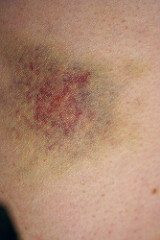
contusion

answer
blood vessel trauma, bruise. color determines the age
question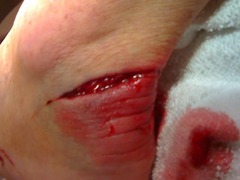
laceration

answer
jagged, torn wound
question
incision
answer
sharp cut tissue with sharp object. clean edge, scar.
question
puncture
answer
deep, penetrates several layers of tissue. sharp object ( knife)
question
bullet wound
answer
different appearance
question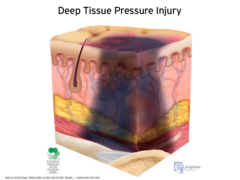
extreme temperature wounds

answer
severity depends on duration of exposure. hot or cold
question
ulcers
answer
inadequate flow flow to the tissue stasis its not pressure ulcers and are diabetic.
question
what are the degree of cleanliness
answer
clean - uninfected surgical wound. 5% of contamination clean-contaminated - it is is in a non sterile place. GI, GU, Respiratory 3-11% contaminated- GI products, ecoli, acute inflammation( appendicitis) or sterile technic is broken . 17% dirty - already infected. gangrene. infection is 20%
question
physiology of wound
answer
primary intention secuntary intention tertiary intention it could be all 3 stages at once and it is progressive.
question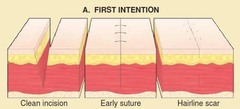
primary intention

answer
the edges of the wound are approximated together (as in a surgical wound) small skin is lost
question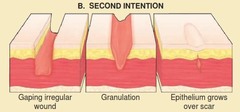
secondary intention

answer
wound edges do not approximate or pus forms and prevents tissue from growing together. larger scar, and wound contraction. less granulated tissue
question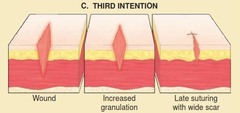
tertiary intention

answer
wound left open and then later sutured.
question
what to look in a wound healing
answer
and the wound odor, describe the dressing, detailed about dressing
question
what are the phases of wound?
answer
inflammation phase reconstruction/ proliferative phase maturation phase
question
inflammatory phase
answer
1-4 days - constictriction of blood vessels - Phagocytes remove debris and protect against infection - Wound becomes red, warm, swollen and painful d/t increased blood flow to the area. - Blood clots dissolve and the sides of the wound begin to grow together and seal up..
question
reconstruction/ proliferative phase
answer
starts 3rd or 4th day and last 2-3 weeks Macrophages (phagocytic) continue to clear debris from the wound Fibroblasts synthesize collagen which adds strength to the tissue. New capillary networks form and begin to supply nutrients to support the collagen Wound forms a raised purplish colored scar.. protein and it A and C to promote healing.
question
maturation phase
answer
The final phase of healing May take up to 2 years Collagen is lysed (broken down) and resynthesized by the macrophages producing strong scar tissue.. keloid
question
types of wound drainage
answer
sanguineous serosanguinous serous purulent
question
sanguineous
answer
bright red, active bleeding
question
serosanguinous
answer
pale red, watery, serous and sanguineous
question
serous
answer
clear, watery plasma
question
purulent
answer
thick yellow green tan. INFECTION pus
question
factors impair wound healing?
answer
age malnutrition obesity impaired oxygenation smoking drugs ( anti-inflammatory, meds, quemo) radiation wound stress moisture exposure .
question
what is a hyperbaric oxygen chamber??

answer
when wound is not healing forcing oxygen into plasma. air pressure in chamber > environment accelerates process of healing
question
wound healing complications??
answer
hemorrhage infection cellulitis fistula sinus dehiscence evisceration
question
hemorrhage?
answer
fresh surgical wounds monitored for this external bright red bleeding from wound
question
what could happen is hemmorage is internal??
answer
hypovolemic shock could occur
question
signs and symptoms of hemorrhage?
answer
decrease blood pressure, increase respiration , diaphoresis, cold clammy skin
question
what is hemmorage is external?
answer
apply pressure with steril dressing
question
internal bleeding/ hemmorage will have this symptoms
answer
patient is pale, cool, diaphoretic, with thready pulse and rapid respirations.
question
with hemorrahge you must
answer
monitor vital signs and notify physician.
question
infections
answer
wound infected during or after surgery color may be brown yellow or green with odor
question
most common infection?
answer
staphylococcus aureus !!!! ecoli, proteus,
question
what is abscess?
answer
localized infection
question
a big type of infection is
answer
gas gangrene
question
what is gas gangrene
answer
Wound with extensive muscle damage infected with clostridium Causes necrosis and gas bubbles in the soft tissue Amputation may result
question
nursing measurements for gas gangrene
answer
pain medication, anti biotics
question
what are symptoms to prevent infection??
answer
redness, swelling, warmth, pain, loss of function, low grade temp. Perform diligent wound care using aseptic technique. Promote good hydration and nutrition. Notify physician of complications. Obtain wound cultures, if ordered. Administer antibiotics, if ordered
question
what is cellulitis
answer
Inflammation of tissue surrounding the wound characterized by redness and induration
question
what is fistula
answer
An abnormal passage between two organs or an internal organ to the body surface
question
what is sinus
answer
A abnormal canal or passageway from inside the body to the outside..
question
what is dehiscence
answer
The spontaneous opening of an incision, the edges of the wound separate A sign of impending dehiscence may be an increased flow of serosanguineous drainage
question
what happens when dehiscence occurs ?
answer
Dehiscence usually occurs between the fifth and twelfth post-operative day.
question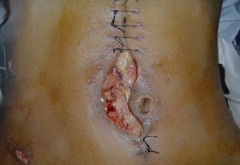
what to do with dehiscence

answer
steril dressing over it (gauze) , keep patient calm, MPO ( no drink or eat) , notify the doctor
question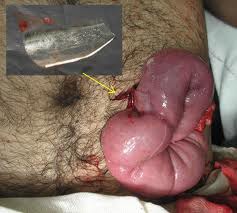
what is evisceration?

answer
protrusion of an internal organ through an incision
question
what to do with evisceration???
answer
keep the dressing with sailing.. moist.
question
patient teaching to prevent dehiscence and evisceration.
answer
Teach patient to support incision with pillow during coughing and position changes. Treat for nausea to avoid stress on incision when vomiting. evisceration occurs, apply sterile dressings soaked in normal saline over the wound opening and cover with dry gauze. Notify physician immediately.
question
what are wound closure
answer
Usually held together by staples or sutures
question
for skin sutures
answer
Sutures beneath the skin are made of absorbable material such as chromic or clear gut and are not removed Large retention sutures may be used if there is a danger of dehiscence..
question
what are drains and drained devices??
answer
Drains may be placed during surgery into a stab wound to allow drainage of blood or fluids Drains may be active (attached to suction or a suction device) or passive (allowed to drain on their own)..
question
types of dressing?
answer
gauze - air to reach wound/ wet to dry telfa- plastic coding to wound surfipads or abdominaal pads (ABD) - large and thick absolve drainage transparent or semi occlusive - let oxygen in and moist but not bad things in hydrocolloid or occlusive - drainage, moisture and liquified narcotic tissue hydrogel - dressing must be cut first
question
wet to dry dressing
answer
Sterile procedure Used as a packing Helps mechanically debride wounds with necrotic tissue As the gauze dries the dead tissue adheres to the gauze and sticks to the dressing as it is removed.
question
what to avoid for wet to dry dressing ?
answer
adding saline when removing dressing for it defeats the purpose Too-wet dressings may cause Common used agents..
question
how do you measure wound?
answer
Measure by length, width and depth. Sometimes a diameter is given for a round wound documentation
question
in what do we measure
answer
cm
question
depth is measured by
answer
put q tip measure the wound and then put it against a ruller
question
what are the treatment of wounds
answer
Grossly contaminated wounds are cleaned at each dressing change Antibiotic solutions may be ordered for wound irrigation Surgical wounds and open wound dressing require sterile technique May require hydrocolloid or wet-to-dry dressing..
question
how do you do irrigation?
answer
from the cleanest to the dirtiest.
question
what is debridement
answer
The removal of dead or damaged tissue from a wound It is performed to promote wound healing by removing the necrotic tissue..
question
what is debridement medical maggots
answer
Known as "biotherapy" Used for non-healing wounds that contain necrotic tissue Useful when multiple surgical debridement is not feasible.
question
what is tape application
answer
ask if allergic Place tape so that wound remains covered by the dressing and tape adheres to intact skin Should be long and wide enough to adhere firmly to intact skin on either side of dressing. Place tapes at the ends of the dressing Place tape opposite to body action in the wound location, should not go across a joint or crease Turn under the end leaving a tab for easy removal When removing pull tape toward wound on all sides.. Montgomery straps for frequent dressing changes
question
cleaning ulcers
answer
Clean ulcers at each dressing change, use only normal saline. Note: If granulation tissue is present and does not exhibit s/s of infection, cleaning is contraindicated. When irrigating wound, use gentle pressure to avoid damaging the fragile tissue. Cover ulcer with a dressing selected for the characteristics of the wound
question
stage 1
answer
film dressing. clear ones
question
nursing measures for pressure ulcers
answer
Assess skin for pale color, warmth in calf area, skin that will not blanch, redness, pain. Notify physician of signs of an ulcer. Elevate feet. Apply TEDs/SCD as ordered. Encourage ambulation. Reposition at least every 2 hrs. Keep bed linens dry and wrinkle free. Clean skin soiled with urine or feces with warm water and mild cleansing agent Use lotions/protective dressings to reduce friction and shearing. Keep HOB as low as possible to reduce shearing. Use special mattress to reduce pressure on skin. Protect skin from moisture. Have patient use trapeze bar to reposition self, if possible. Remind patient and family to reposition often to relieve pressure and not any new areas of redness on bony prominences.
question
stasis ulcers
answer
Ulcers on the lower legs caused by poor circulation to the legs r/t burns, diabetes, severe varicose veins or sickle cell anemia Treatment is with wet-to-dry dressings, surgical debridement, unna paste boot or other dressing (the only ulcer to use Unna Boot)..
question
Suture Removal
answer
Sutures often are removed by the physician Sutures are cut and pulled through the skin Sterile technique should be used Parts of sutures left under the skin may cause inflammation Staple removal requiresa special instrument Steri-Strips are usuallyapplied after removalof sutures or staples..
question
eye irrigation
answer
Supine with affected eye down Inner to outer canthus to decrease absorption of contaminants thru nasolacrimal duct
question
ear irrigation
answer
Body temp solution Never push fluids under pressure
question
contraindication for ear irrigation (never do it ) if
answer
Vegetable in ear Has cold Increase temperature Ear infection Injured/ruptured tympanic membrane



